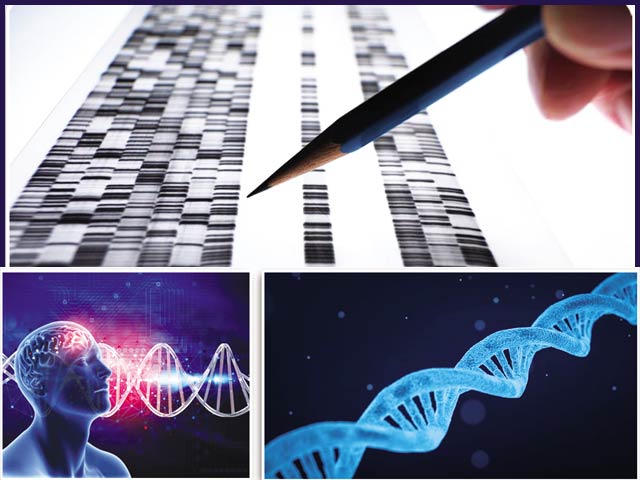A major scientific effort 20 years ago revealed that the human genome contains 20,000 protein-coding genes, but these genes make up only two percent of human DNA. At that time, it was thought that the rest of the DNA was not important, but now it is being realized how important a role they play.
In April 2003, the 13-year scientific effort to unravel the mystery of the ‘book of life’ within the human genome was declared complete. At that time, there were high expectations that through the “Human Genome Project”, which cost three billion dollars, cures for many diseases would be discovered and new secrets about human life would be revealed.
While heralding the start of a new era of biological understanding during a press conference, this informative manual on human life came as an unexpected surprise. At the time, it was widely believed that the majority of the human genome would contain the instructions for making proteins, the basic building materials in every organism that perform surprising roles inside and outside cells.
There are more than 200 types of cells in the human body, and it was not surprising to imagine that each cell would require a different type of genetics. Of the three billion characters in the human genome, less than two percent are reserved for proteins, which number around 20,000.
Geneticists were surprised to learn that humans have as many protein genes as many other organisms on Earth. This discovery put the world of science in a new problem and the question arose before them that maybe our understanding was wrong?
Sameer Haya is the chief executive of a therapeutics company that is trying to understand human genetics to discover cures for heart disease, cancer and other diseases. “I remember the moment when a lot of people started wondering if our ideas about biology might be wrong,” he says. Genome’ was named.
It was a mysterious mass of letters that we neither knew the meaning nor the purpose of. Some geneticists initially suggested that the dark genome probably had no purpose and was the garbage accumulated by human evolution, leftover bits of genetics whose purpose had been lost over time. However, other experts believed that the genome was essential to understanding humanity.
Carrie Stephenson is the chief executive of Decode Genetics. “Garbage has no place in development,” she says. “There must be a reason why the size of the genome remains the same.” After two decades, some information about this dark genome is emerging.
Its main purpose is to keep the decoding process of genes that make proteins going and it controls the behavior of human genes in environmental or external stressors that the body faces, including factors such as diet, exercise, sleep, etc. Called ‘Epigenetics’.
Sameer says he thinks proteins are the hardware of life, while the dark genome is the software, and the more we learn about this mysterious genome, the more we can learn about human complexity. “Humans have constantly adapted to the environment and when we think about why we are different from a fly, the answer lies in the dark genome,” he says.
Evolutionary past
When scientists began reading the book of life, DNA, in the year 2000, one of the difficulties was that the parts of the human genome that did not code for proteins contained many forms of identical DNA called ‘transposons’. is called.
They were so abundant that half the genomes of all mammals contain them. Jeff Boeck runs the Dark Matter Project at New York University. “The creation of the first human genome was made difficult by these identical DNAs because it is easier to analyze a DNA if it is unique,” he says.
Early on, geneticists ignored transposons and focused on the genome’s tiny protein-coding ‘exome’. But advances in technology over the past decade have made it possible to better examine the dark genome.
In one experiment, researchers removed a specific transposon in the DNA of mice from an animal that resulted in more than half of its offspring dying before birth.
This suggests that some transposons may be essential for our survival. The presence of transposons in the genome may be explained by the fact that they are quite ancient, dating back to the earliest forms of life on Earth, says Jeff Boeck.
Other scientists say they are caused by viruses that have attacked DNA throughout human history but over time integrated into the body for another purpose.
Jeff Boeck considers the Dark Genome to be the most important living record of changes in human DNA that occurred long ago. An interesting feature of transposons is that they can be transferred from one genome to another and hence their name because they can cause dramatic changes in genetics. Due to their similar movements, it is possible that the monkey family died out and man also started walking upright.
Jeff says it was a change that had a profound effect on evolution. While the dark genome may reveal the secrets of human evolution, it may also reveal how a disease develops.
Sameer says research shows that most of the genetics linked to long-term diseases, such as diabetes and heart disease, are not in the protein-coding parts of DNA, but in the dark genome.
The Dark Genome and Diseases
Pawan Island in the Philippines is famous for its white sand and tourism. But this beautiful place also hides a painful secret. The island has the highest number of cases worldwide of X-linked dystonia-parkinsonism, a disease that affects movement. No cure has been found for this disease so far. Like Parkinson’s, the ability of people affected by this disease to walk and react quickly to any situation is affected.
Since the disease was first discovered in 1970, it has been diagnosed only in people from the Philippines. It was a mysterious case that was revealed when geneticists discovered a unique gene called TAF1 in these individuals.
The symptoms of this disease seem to be linked to a transposon in the middle of the gene that controls the gene’s function in such a way that the body begins to suffer damage over time.
This gene is believed to have originated two thousand years ago, after which it continued to be transmitted to the human population. Jeff Boeck says that TAF1 is an essential gene, which means that it is required for the development of all cell types, and if it is mutated, it manifests itself in certain types of disease. This is a simple example of how a few DNA sequences in the dark genome drive different genetic functions.
The dark genome also provides instructions for making a variety of molecules, called non-coding RNAs, whose functions can range from making proteins to inhibiting protein production.
Sameer says that RNA tells how DNA will behave to some kind of change in the environment. And now these non-coding RNAs are being looked at with the view that they may show connections in the dark genome and various long-term diseases.
It is believed that if the dark genome receives constant signals of the wrong kind, such as smoking, poor diet and a lifestyle of limited movement, the RNA molecules it produces predispose the body to disease and Genetic activity is altered in such a way that cells begin to die. It is also thought that certain RNAPs can turn off or increase the activity of a gene called fifty-three, which normally prevents cancer from forming.
A large number of non-coding RNAs may act together in complex diseases such as schizophrenia or depression. However, the importance of the dark genome is now being realized in the treatment of such diseases. While the pharmaceutical industry has focused on proteins, a few companies are now exploring how to influence RNA to make new treatments for these diseases possible.
On the other hand, in the field of cancer vaccines, attention has been focused on the protein coding part of the genome. But the German company CureVac is pioneering an effort to find a cure for cancer through the non-protein coding part. Sameer’s company, Haya Therapeutics, is trying to develop a drug that can target non-coding RNAs that cause heart disease.
He says, “The problem with protein coding DNA is that there are only 20,000 of them in the body, but there are non-coding RNAs in the dark genome that cause disease only in the heart, so they are targeted.” By making we can make a safe medicine.” However, it is a fact that we only exist at the level of dark matter or the dark genome and do not know much.
“Now we’ve got a head start and the next 15 to 20 years will just be about identifying specific behaviors in cells that cause disease and then identifying those parts of the dark genome,” Hockmeier says. Try to identify what causes these behaviors. The real thing is that we now have tools available to do this that we didn’t have before.”
“As we learn more, the book of life and surprises will be revealed just as they were twenty years ago,” Hockmeyer predicts. are Have our genetics changed over time? Are we going to decode it completely?” According to Hockmeyer, we are trying to enter a vast but dark space and there are still many discoveries to be made. (Courtesy of the BBC)
(function(d, s, id){
var js, fjs = d.getElementsByTagName(s)[0];
if (d.getElementById(id)) {return;}
js = d.createElement(s); js.id = id;
js.src = “//connect.facebook.net/en_US/sdk.js#xfbml=1&version=v2.3&appId=770767426360150”;
fjs.parentNode.insertBefore(js, fjs);
}(document, ‘script’, ‘facebook-jssdk’));
(function(d, s, id) {
var js, fjs = d.getElementsByTagName(s)[0];
if (d.getElementById(id)) return;
js = d.createElement(s); js.id = id;
js.src = “//connect.facebook.net/en_GB/sdk.js#xfbml=1&version=v2.7”;
fjs.parentNode.insertBefore(js, fjs);
}(document, ‘script’, ‘facebook-jssdk’));



